new posts in all blogs
Viewing: Blog Posts Tagged with: Outdoor activities, Most Recent at Top [Help]
Results 1 - 25 of 46
How to use this Page
You are viewing the most recent posts tagged with the words: Outdoor activities in the JacketFlap blog reader. What is a tag? Think of a tag as a keyword or category label. Tags can both help you find posts on JacketFlap.com as well as provide an easy way for you to "remember" and classify posts for later recall. Try adding a tag yourself by clicking "Add a tag" below a post's header. Scroll down through the list of Recent Posts in the left column and click on a post title that sounds interesting. You can view all posts from a specific blog by clicking the Blog name in the right column, or you can click a 'More Posts from this Blog' link in any individual post.
With days getting shorter and cooler, we often lament the coming of winter. When we move indoors it seems like we miss out on some of the creatures in the natural world. But, you can have birds in your yard all winter long by spreading out seeds and suet to attract them. Here’s Shiela Fuller’s recipe for HOMEMADE SUET:
HOMEMADE SUET for bird feeding
Feeding winter birds is a rewarding winter activity for adults and children. The general agreement is if you provide winter foods, you should also provide a water source and hiding places for protection from predators. This means, place your feeder near trees or bushes that give quick cover.
There are many different varieties of bird species to see right outside your window. Common seed eating varieties are the blue jay, tufted titmouse, and black capped chickadee. If you are lucky you might catch a glimpse of an Eastern towhee or yellow-rumped warbler passing through on migration. The insect eating winter birds such as the downy woodpecker, the red-bellied woodpecker, and the nuthatch especially enjoy suet.
Making your own healthy version of bird suet is so easy to do.
Gather the ingredients:
1. bacon fat (the leftover liquid fat after you’ve cooked it)-throughout the year collect the leftover fat in a jar and keep in your fridge.
2. rolled oats
3. peanut butter
4. dried fruits , nuts, and/or seeds
5. commercial bird seed
Process:
Combine one part bacon fat and peanut butter and melt in a saucepan. Add the additional ingredients to make a thick concoction.
Cool and pour into an empty box that give will your suet shape. A half gallon milk or juice carton is perfect for this. Place in freezer.  When solid, peel back the carton and slice the cake into ONE INCH THICK pieces that you can insert into your suet feeder or hang from a wire basket.
When solid, peel back the carton and slice the cake into ONE INCH THICK pieces that you can insert into your suet feeder or hang from a wire basket.
Keep the remaining suet in the freezer until needed. Since this has no artificial preservatives, recommended use is at 38* F or colder.
It won’t be long before the birds will make your backyard their home.
Shiela Fuller has been a Cornell University Project Feeder Watch participant for many years and an avid birder since 1988. Currently, she enjoys writing picture books, yoga, chicken raising, wildlife photography, and is the legacy keeper for her family.


Note: This information is taken from an article written by W. Douglas Tynan, director of Integrated Health for the American Psychological Association. It is paraphrased from the Sunday October 26,2014 edition of the Philadelphia Inquirer. You can find more on this topic and other health topics on his website about healthy kids at: http://www.Philly.com
We all know that exercise is good for the heart and body. Staying fit with regular exercise helps children grow stronger and ward off obesity. But there are several studies that have found exercise to be EXTREMELY BENEFICIAL to children’s developing brains.
Charles Hillman from the University of Illinois found that kids who participated in regular physical activity – 60 minutes per day – enhanced cognitive performance and brain function. The study measured one hour of vigorous exercise followed by 45 minutes of a less vigorous skills game for a total of two hours every day after school for 150 days of the school year. On measures of concentration, attention, impulse control, flexible thinking and brain activity (measured by scalp electrodes), the 8-9 year old studied, did much better overall than their sedentary peers.
A second study by Catherine Davis at the University of Georgia, with older children who were overweight and did low level (20 minutes per day) and high level (40 minutes per day), for only 15 weeks had the same results, along with better scores in concentration, math and impulse control. If a prescription medication showed the same results, people would be lining up to buy it. If there was a curriculum that showed this benefit, school districts would be signing up in droves.
But, it is NOT a product, but rather a lifestyle to be taught at home and in school. The best way to get children to do their best in school is to GET THEM TO MOVE! Instead of eliminating physical education programs, we should be expanding them. The most intriguing part of these studies was the gain in impulse control. Is it my imagination, or were there fewer children with ADHD 50 years ago when recess and backyard play were popular staples of every neighborhood? I’d love to hear your views on this interesting topic.
The importance of these findings


By: darlenebeckjacobson,
on 8/22/2014
Blog:
Darlene Beck-Jacobson
(
Login to Add to MyJacketFlap)
JacketFlap tags:
Science activity,
healthy eating/snacks,
Home Schooling Ideas,
honey recipes,
http://sweetvirginia.com,
raising bees,
taking kids to and apiary,
Children,
Recipes,
Nature,
Activities,
video,
animals,
web sites,
Outdoor activities,
cooking with kids,
summer fun,
Add a tag
Jersey Farm Scribe here, and I’m so excited to do a post here on Darlene’s website.
It’s exciting for me to get a chance to talk about something farm-related, since I’m usually posting on writing on Kathy’s website Writing and Illustrating or Children. http://www.kathytemean.wordpress.com
I thought about what I should write about. I could write about the animals that I have here on The Farm. I could write about the lifestyle, being more in touch with the world around us, agriculture and fresh food. I could write about one of the many projects that are always going on… and never quite finished.
In the end, I decided to write about something close to my heart that I HAVEN’T gotten fully involved in. What a great motivator for me to finally jump in!!! Plus, then perhaps I can do another post in a few months and update everyone on any progress that has been made.
So here we go… they’re cute… they’re amazing,
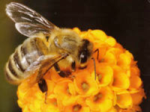
honey bee
and they’re SUPER sweet. I had the amazing opportunity to visit an active BEE hive with my brother’s family, including their bee-guru boys. We went to Dan Price’s Farm, the founder of Sweet Virginia Foundation http://sweetvirginia.com, a Honey Bee Conservation and Education Organization. Here we all are at their farm. The three little ones are three of my four amazing nephews. I’m the odd-ball in the green suit.
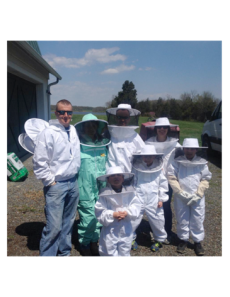
There were some high school kids doing a project. The high schoolers were very leery of the bees, (understandably), and a bit skittish about going up to the hive.
My nephews, 12, 11 and 7, had absolutely no problems. They were informing the older kids of where to stand that was safe. (bees create a main highway where they travel in and out of the hive, and as long as you keep that area clear, you’re perfectly fine!) They operated the smoke puffer (definitely NOT it’s technical name) and answered all the questions the hive experts had like it was NOTHING.
Hive Manager: Does anyone know how many different types of honeybees there are?
7 yr-old-nephew (looks at her as if to say, um, who doesn’t??: Three. The queen. The worker bees, which are girls, and the drones, which are boys.
Hive Manager: That’s right. And the bees that we see flying around sometimes, which are they?
11-yr-old: Worker bees.
Hive Manager: And why’s that?
12-yr-old AND 7-yr old: Because they are the only ones that leave the hive. All the drones do is mate with the queen and all the queen does is lay eggs.
Eventually, the hive manager realized she was going to have to think of harder questions.
Then Marcus and Ethan, the 11 and 7-yr olds picked up a BEE COVERED slat from the hive, (without any gloves on!) and with absolutely no fear:
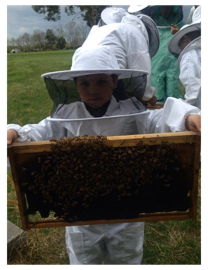
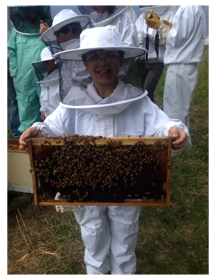
And here is Jared, (12) even letting a bee crawl on his hand!
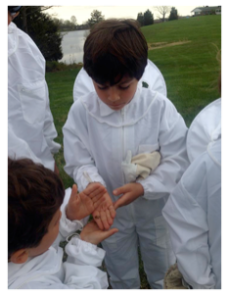 I was unbelievably impressed, to say the least. (as were the high school kids who they completely showed up!)
I was unbelievably impressed, to say the least. (as were the high school kids who they completely showed up!)
I learned a lot. I won’t get into the dorky-science details here. (I’m a total science nerd at heart). But here’s a fun one: Bees communicate with DANCE!
Seriously… how cool is that?
PBS has a great video on The Waggle Dance: http://video.pbs.org/video/2300846183/
They use it to communicate where the good hive or flower is located. It’s pretty unbelievable.
I think most people know at this point that there are concerns for the honeybee’s health around the world, which would be devastating to our food sources. It’s more than just not having beautiful flowers. Fruits and vegetables pollinate and grow because of bees. And the animals that we raise for food eat these fruits and vegetables as well!
But luckily there is something really simple you can do that can make a BIG difference! You know those signs you see? 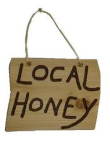
Those are people who either run their own hive, or have someone come in and run a hive for them. This is GREAT for the honeybee population. You can help out your local farmer, and help the honeybees at the same time.
Honey is such a great natural sugar substitution. Try substituting it for sugar in recipes, to give an extra yummy flavor, and a much healthier sweetness. Sugar is sweeter than sugar, so you would about ½ to ¾ cup of honey for every cup of sugar.
I do a combination:
For every cup of sugar a recipe calls for I use:
¼ cup sugar
½ cup honey
This is amazing in almost ALL baking, cakes, muffins, cookies, breads, the works.
Honey has some pretty amazing healing powers as well. It’s been used as a natural antibacterial agent for years!
Feeling like you have a cold coming on, or just can’t kick one? Try this:
Hot water
Raw Honey – (natural antibacterial agent and throat coater)
REAL ginger – (natural anti-inflammatory)
REAL garlic – (natural antibiotic)
1 teaspoon apple cider vinegar (with the mother) (balances the acidity level – excellent for chest cold)
Okay…. so I’m not gonna lie, this is not a delicious drink. But I can from personal experience it can really help to kick those sniffles!
Allergies? Try local honey. A full T every single day. The closer the hive is to your home, the better.
The idea is that you’re introducing a small amount of the pollen into your system via the honey, making your body more use to it (similar to how allergy shots work). This method of course depends on what you are actually allergic to, and there is actually not a lot of actual pollen in honey, but there is some.
I am lucky and don’t suffer from allergies myself, but I have a few friends I’ve suggested this to that swear it helped them. Plus, this one IS delicious!
(I am obviously NOT a doctor, these are just personal home-remedies I’ve always used)
Kids definitely like finding out where their food comes from. And there are also some GREAT Kid-Friendly Honey Recipes: Bite-size Honey Popcorn Balls http://www.myrecipes.com/recipe/bite-size-hiney-popcorn-balls-10000001661174 
Honey Glazed Carrots http://www.tasteofhome.com/recipes/honey-glazed-carrots
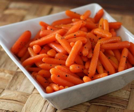 And of course, a great dipper for apples, carrots, fruit, bread, chicken, you name it!!!!
And of course, a great dipper for apples, carrots, fruit, bread, chicken, you name it!!!!
So next time you see a local sign for…
 … take a quick stop and find out where their hives are located. You may end up in a more interesting conversation that you’d expect!!
… take a quick stop and find out where their hives are located. You may end up in a more interesting conversation that you’d expect!!
As for me? I plan on trying to get a hive on my property by 2015.
And a big thank you to Darlene and all of you, because you all are part of what has motivated me to pursue it!!
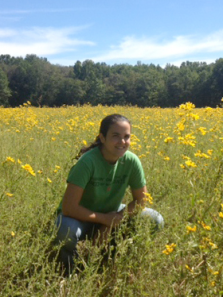 Erika Wassall, The Jersey Farm Scribe is a writer, a farmer and a liver of life. Check out her posts on Writing and Illustrating for Children every other week, and follow her on Twitter @NJFarmScribe.
Erika Wassall, The Jersey Farm Scribe is a writer, a farmer and a liver of life. Check out her posts on Writing and Illustrating for Children every other week, and follow her on Twitter @NJFarmScribe.


One of my favorite summer activities is being out on the water in a boat, enjoying the afternoon sunshine as the boat – any boat – glides through the water. Even if you can’t take a ride in a people-sized boat, you and your kids can make an amazing flotilla of boats using all kinds of recycled materials. And, best of all, they all float! So save your egg cartons, margarine tubs, seashells, and sponges and get ready to have a boat race in your pool or even in the bathtub. Don’t forget to take a video of the event and who knows, it may become an annual tradition.
Check out the model boats at: http://www.redtedart/2013/06/08/boat-craft-ideas-for-summer
Many of the boats have video instructions and cost little in terms of materials. Happy sailing! 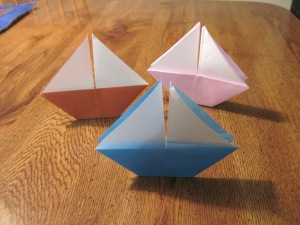


One of my favorite summer beach activities has always been playing in the sand. It was so satisfying to fill up the bucket with damp sand and turn it upside down to create the turrets and towers of a sandcastle. Last week I witnessed sand art on a grand scale.
Atlantic City NJ hosted the Sand Sculpting World Cup. This amazing display – held on the Pennsylvania Ave. beach next to the Steel Pier – draws artists from all over the world for the three week event. All the sculptures are made with only sand and water. A special “sticky” sand is brought in for the artists to use. Once their creations are complete, a fine spray of watered-down Elmer’s glue keeps the sculptures from succumbing to the elements during the three week show. Here is just a sample of t he magnificent creations:
he magnificent creations: 
The competition originated in 1897 and was held non-stop until 1944, drawing people from all over to Atlantic City. Sand art became so popular, it was immortalized on postcards around the world. When the city was ravaged by an unnamed hurricane in 1944, the event was stopped until it resumed 15 years ago.
If you missed this amazing display of sand art by the best sculptors in the world, check out the website and make plans to visit next year. You won’t be disappointed.
http://www.doatlanticcity.com



The First Place Winner.


By: darlenebeckjacobson,
on 6/22/2014
Blog:
Darlene Beck-Jacobson
(
Login to Add to MyJacketFlap)
JacketFlap tags:
Children,
Nature,
Activities,
bird watching,
Outdoor activities,
summer fun,
Science activity,
Home Schooling Ideas,
caring for baby birds,
www.cedarrun.org,
Add a tag
It’s summer!
If you’ve maintained a wild bird backyard habitat throughout winter, you can continue through summer with added benefits. Providing food, water and shelter encourages birds to build a home and raise young when resources are plentiful. Fill a suet feeder with nesting supplies such as yarn threads, strands of hair, and broom bristles. Keep a part of your yard “natural” with a pile of leaves and pine needles, to offer a variety of supplies for birds to choose from. Keep your eyes out the window and take note to which birds make use of your materials.
Many birds will make their nest in close proximity to humans. Robins and mourning doves are known for making nests in shrubs, trees or on wooden ledges under decks. Swallows will build a nest from mud and attach it to the side of the house. Wrens love small bird houses and especially those that can safely swing in the breeze. Be on the lookout for neighborhood cats who like to lunch on unsuspecting baby birds. Snakes can also end the enjoyment of raising baby birds in your yard. I don’t recommend killing snakes as they also provide an important service in the ecosystem, but it’s never a good day, when a snake is found inside a nest box full of black-capped chickadees. 
In addition to prey, another hazard for baby birds is falling from the nest. If a baby bird found is very small and most likely dead, it has been pushed out by more aggressive siblings or from nest over load. If you find a baby bird that has feathers and can hop but cannot fly, it is most likely a fledgling, just learning to fly. Contrary to popular belief it is OK to pick up and replace the baby to its nest. Or, if it looks like the parents are attentive, leave it alone. If you cannot find the nest, place the bird in a tissue lined box in the same location in which it was found. Watch to see if the parents return to feed. Many do. If after a few hours you can’t be sure the parents are around, your best option is to take the baby to a local wildlife center. The people there will nurture the baby until it can survive on its own and usually return the bird to its original locale. 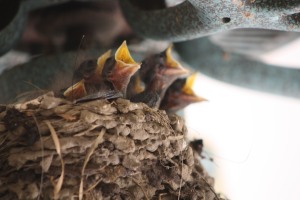
Woodford Cedar Run Wildlife Refuge is in southern New Jersey and takes in wildlife of all varieties.
6 Sawmill Rd, Medford, NJ 08055
(856) 983-3329
http://www.cedarrun.org
Another note of caution, be careful of tree cutting in the spring and summer. Many nests have been dislocated when unsuspecting tree cutters take down a bird’s summer home.
Taking care of our feathered friends can be a rewarding and enjoyable experience for young and old alike. Why not invite some birds into your backyard this summer?
Shiela Fuller has been a Cornell University Project Feeder Watch participant for many years and an avid birder since 1988. Currently, she enjoys writing picture books, yoga, chicken raising, wildlife photography, and is the legacy keeper for her family.


By: darlenebeckjacobson,
on 6/19/2014
Blog:
Darlene Beck-Jacobson
(
Login to Add to MyJacketFlap)
JacketFlap tags:
beach activities for children,
www.beachtomato.com,
www.craftionary.net,
www.readingconfetti.com,
Children,
Activities,
web sites,
Outdoor activities,
summer fun,
www.enchantedlearning.com,
Home Schooling Ideas,
Add a tag
My blogging friend Gail Terp has some wonderful ideas for extending learning throughout the summer…even while at the beach. Kids will be having so much fun, they won’t realize they’re also learning. Here’s Gail:
Going to the beach? Looking for ideas for fun, exploration, and learning? Here are some good places to start. There are activities and fun for kids of all ages.
25 Beach and Ocean Activities for Kids from Reading Confetti
LOTS to do here: sensory play, crafts, literacy activities… http://www.readingconfetti.com
The Beach from Enchanted Learning http://www.enchantedlearning.com
Rhymes, crafts, and printables
10 Best Beach Games from Mom.me http://mom.me/playroom/7916-have-blast-beach/
Games for active beach play
22 Summer Beach Activities Fun for Kids and Parties from Craftionary
Activities, crafts, ideas… http://www.craftionary.net
Preschool Beach Games from Everything Preschool
Intended for the young set but some stuff older kids might like http://www.everythingpreschool.com
Best Beach Games from Beach Tomato http://www.beachtomato.com
Good ideas for older kids
Have a great time at the beach! 
Next Friday Gail will have tips for how to encourage reading throughout the summer.


I can think of few things that bring out the kid in all of us more than bubbles. What is it about soapy water that is so much fun? As the dog days of summer beckon, here are a few water related activities you and your children can enjoy throughout the warm weather season.
1. Water painting. This is a great activity for keeping little ones occupied. All you need is a bucket of water and some paintbrushes of various sizes. Add a few drops of food coloring and let the kids “paint” to their hearts content. They can paint the sidewalks, steps, driveway. So what if they get wet or spill the “paint” – it’s only water.
2. How about making your own bubble wands and bubble solution? It’s easy to bend wire into wands for blowing bubbles of all sizes. And Red Ted Art has a great recipe for soap bubble solution: Easy as 1…2…3
Gently mix together: 1 liter (1/5 gallon) of hot water, 1C good quality liquid soap, 2-4 T glycerin (this makes the bubbles thicker and longer lasting and is available at craft stores or supermarkets). Gently stir and leave overnight. The longer you let it set, the better the bubbles will be. If you’re using it for a party, make it a couple days ahead.
Check out Red Ted Art for other outdoor fun activities. http://www.redtedart.com
3. Put on your bathing suits and have a Water Balloon Fight. You can get a bag of water balloons at most Dollar Stores. Fill them with water, and once you have a pile, have a blast (pun intended).


Now that summer vacation is here, why not try taking the kids for a real adventure by exploring nature’s wonders at a nearby forest or state park. These beautiful, natural areas are in every state and many have free activities for the whole family. Camping, hiking, bird watching, water sports, fishing and learning about plants and animals are some of the things you can discover at your local park, forest or nature preserve.
Visit: http://www.discovertheforest.org for tips on how to enjoy nature, how to be safe in wild areas, and DID YOU KNOW facts. All you have to do is enter your state and a list of all the forests and wildlife areas will appear. Discover your inner explorer by visiting a forest or natural area this summer. You won’t be sorry.

Boston Arboretum


By: darlenebeckjacobson,
on 4/24/2014
Blog:
Darlene Beck-Jacobson
(
Login to Add to MyJacketFlap)
JacketFlap tags:
Outdoor activities,
Science activity,
organic food/farms,
Home Schooling Ideas,
raising free range chickens,
Children,
Nature,
Activities,
bird watching,
Add a tag
My fellow writer and occasional visitor to this blog, Shiela Fuller is back with her wonderful post on how to raise your own free range chickens. Here’s Shiela:
Long before there were confined feeding animal operations (CAFO), people raised egg laying chickens in their backyards. As the inhumane treatment of mass produced farm animals for food becomes widely recognized, more individuals are turning to traditions of the past and again raising egg layers for their own use.
The instructions that follow for raising chickens are easy, but these are live animals that require care and supervision just as domestic animals do.
DOES YOUR MUNICIPALITY ALLOW FARM ANIMALS?
The prospective chicken owner must first research and determine if their municipality has regulations against the keeping of farm animals. If not, begin the search for a hatchery.
LOCATE YOUR NEAREST HATCHERY: Your two day old chicks will most likely be shipped by U.S. mail. A decreased distance from home to hatchery means your chicks will arrive quicker, less stressed and in better condition. Don’t be tempted to purchase the cute chicks you see for sale at your local farm and garden store. All chicks look alike at two days old, but at four months your cute chicks could grow up to look like this: 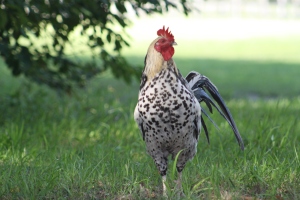
WHEN TO ORDER
Plan to have your chicks arrive late spring/early summer. Order an egg laying breed such as the Rhode
Island Red or a mixed breed. Order your chicks with their beaks intact. You will have to ask for this as
hatcheries raise chicks by the tens of thousands and debeaking is done routinely as a matter of safety
and well-being for the large numbers that are kept in confinement.
HOW MANY TO ORDER: Order the number of chicks dependent on your available space. If your adult hens will free range on an acre, 15 chicks will be suitable. If you are limited to keeping your adult hens in a backyard enclosure, six chicks will be sufficient. Unless you plan to go into the business of selling eggs, 15 egg layers will create a sufficient supply. Once egg laying begins, hens routinely lay one egg per day for up to two years. They lay more productively in summer than winter, too. This is because egg laying is dependent on the number of daylight hours.
YOU’VE PLACED THE ORDER. You now have a delivery date. Call your post office and give them the information and your phone number. They will call you as soon as your chicks arrive.
WHILE YOU’RE WAITING: Assemble the things you will need to house your new arrivals. If you don’t have any of these items on hand or cannot borrow, purchase:
a large plastic tub with sides high enough that chicks cannot jump out, (for extra security a sheet of screen over the top will also help keep the chicks secure), a bag of cedar shavings, a heat lamp with a secure fastener, waterer, organic chicken crumbles.
Set up your chick’s housing in the location you have chosen. A warm kitchen, an out of the way mud room, or even the garage will be suitable. Place about three inches of cedar shavings in the bottom of the tub, securely fasten the heat lamp about 20 inches above the floor of the chick’s enclosure, put fresh cool water in the waterer, and offer plenty of crumbles.
THE CHICKS HAVE ARRIVED: The chicks will arrive in a ventilated cardboard box. Pick them up promptly from the post office and settle them into their new home. 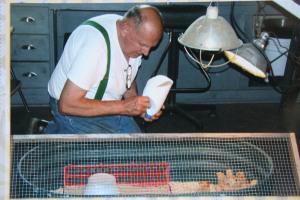
Pick each chick up individually and place them in their warm , draft free environment. Dip each chick’s
beak quickly in the water to induce drinking. This will also help “freshen” any chick that may have
arrived in an overstressed condition. Keep the food bowl filled as chicks eat constantly, and clean, as
chicks do not discriminate between the toilet area and feeding area. Pay attention to the comfort of the newly acquired chicks. Use the huddle indicator: If they huddle together, your lamp is too far from the chicks; if the chicks huddle in the corners, away from the heat source, the lamp is too close.
DAILY ROUTINE:
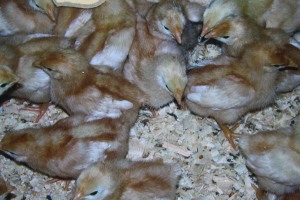 Maintain a bed of clean, dry shavings daily as it will become soiled from spilled water, food and excrement. The chicks will grow quickly and may need to be moved to a larger indoor container, such as a large dog crate. Use your judgement. By this time, you will feel accustomed to taking care of your chicks and will know when they are over crowed and need larger housing.
Maintain a bed of clean, dry shavings daily as it will become soiled from spilled water, food and excrement. The chicks will grow quickly and may need to be moved to a larger indoor container, such as a large dog crate. Use your judgement. By this time, you will feel accustomed to taking care of your chicks and will know when they are over crowed and need larger housing.
MOVING DAY: By about six weeks of age the chicks will have most of their feathers and if the outside temperature is warm, they can be moved to their outdoor location.
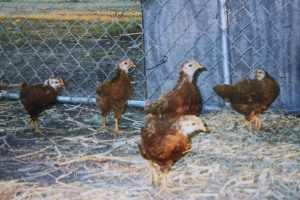 Much care needs to be taken as to the safety of your flock. Opportunistic predators such as snakes, hawks, owls, and foxes love captive prey. Even chicks that will eventually free range will need a place for safe keeping at night time.
Much care needs to be taken as to the safety of your flock. Opportunistic predators such as snakes, hawks, owls, and foxes love captive prey. Even chicks that will eventually free range will need a place for safe keeping at night time.
OUTDOOR HABITAT: For a small flock of confined hens or a free range flock that need a safe keeping place,a suitable arrangement can be made from the following items:
an 10 x 10 outdoor dog kennel, or larger; an outdoor dog house, plastic netting for a cover, fresh hay for filling house and box, egg laying box, perching area, organic egg layer pellets and water bowl.
Dig an area 10 x 10 in diameter and drop your kennel into the earth. This aids in keeping the digging predators, like foxes from gaining entrance and eating your hens. Cover the enclosure with netting to keep out the flying predators. After four months of age, the hens will have grown too large for snakes to consume, so they become less of a problem.
The egg laying boxes, feed bowls, and waterer, the perching area below. 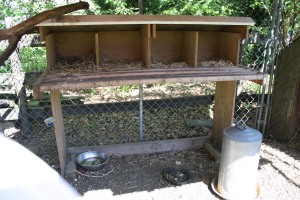
The housing is made from a dog box and plastic cover.
Congratulations! You have successfully raised chicks to egg laying hens. You will make mistakes and learn more as you move along in your chicken adventure. Some additional facts:
—Chickens will eat much more than crumbles and pellets. Offer them seeds, produce and vegetable leftovers, both cooked and uncooked. Free range hens will also consume baby birds, mice and toads. Chickens have individual food preferences.
—Once your free range chickens are accustomed to their new outdoor accommodations, free them in the morning and near dusk they will (they should) return to the enclosure to be locked in for safe keeping at night.
—A rooster is not necessary for egg layer success.
—The chickens will eventually see you as their food source and will run to you upon calling them.
—As was said earlier, snakes are not a problem once your chicks are too large to be consumed, but at some point you may be startled to find one in your hen enclosure:
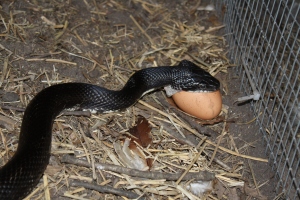 Keep in mind snakes are an important part of the ecosystem. You can spare an egg or two!
Keep in mind snakes are an important part of the ecosystem. You can spare an egg or two!


By: darlenebeckjacobson,
on 4/20/2014
Blog:
Darlene Beck-Jacobson
(
Login to Add to MyJacketFlap)
JacketFlap tags:
Children,
Nature,
Activities,
web sites,
Outdoor activities,
spring activities,
Home Schooling Ideas,
free milkweed seeds,
how to attract butterflies,
www.eartheasy.com,
www.lifefactory.com,
www.localharvest.com,
www.newwaveenviro.com,
Add a tag
On Friday’s post I gave you some simple ways we can be kind and care for Mother Earth. Here are a few more.
1. Shred non glossy paper and use it to mulch plants.
2. Make your own non-toxic cleaners. There are great recipes at: http://www.eartheasy.com
3. Choose containers with 1 or 2 numbers since they are easiest to recycle.
4. Buy a water filter for the faucet or use a filtered pitcher. Carry a stainless steel or glass bottle with you instead of those plastic bottles that not only cost so much to produce, but clog up landfills as well. Visit http://www.newwaveenviro.com or http://www.lifefactory.com
5. Build a compost bin for you food scraps. We incorporate the nutrient-rich scraps into the garden beds each spring and have little need to add fertilizer to produce great veggies.
6. Buy produce locally and in season. Visit http://www.localharvest.org to find farmers’ markets and fresh produce in your town.
7. When you mow the lawn, skip bagging and leave clippings on the grass. It nourishes the soil.
8. Hang clothes to air dry when possible.
Now, I promised you free seeds for attracting butterflies to the garden. Go to: http://www.livemonarch.com/free-milkweed-seeds.htm Not only will you bring beauty to your own habitat, but you will be helping an endangered species: THE MONARCH BUTTERFLY, who lays its eggs on the milkweed plant.
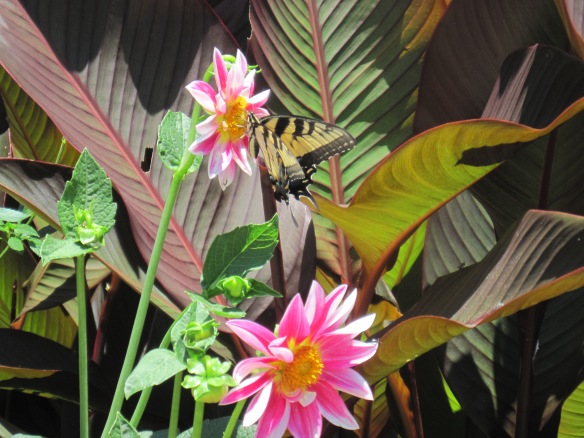


By: darlenebeckjacobson,
on 4/17/2014
Blog:
Darlene Beck-Jacobson
(
Login to Add to MyJacketFlap)
JacketFlap tags:
Children,
Inspiration,
Nature,
Activities,
web sites,
Outdoor activities,
spring activities,
good health habits,
Home Schooling Ideas,
Earth Day activities for kids,
www.creatingreallyawesomefreethings.com,
www.earthday.org,
www.recyclingcenters.org,
www.wikihow.com,
Add a tag
Earth Day helps us focus on being kind to our planet. We often take for granted all the wonders this beautiful place we call home provides. To honor the earth, on Earth Day, and every day, here are some things you can do:
1. Recycle EVERYTHING you can. Find a list at http://www.recyclingcenters.org
2. Repurpose and find other uses for objects you used to throw away. One example is to use empty tin cans and jars for pencils or flower vases. Visit http://www.creatingreallyawesomefreethings.com to find some great “tin can crafts”.
3. Instead of the cardboard coffee cup sleeve, check ebay.com for unique and clever cotton and knitted reusable coffee cup sleeves.
4. Learn how to make yarn from plastic bags (plarn) at: http://www.wikihow.com
5. Donate your old electronics by visiting: http://www.pickupplease.org for details.
6. When shipping items, use old newspapers for packing instead of Styrofoam peanuts.
7. Catch rain in buckets to water the garden.
8. Use bar soap instead of liquid in plastic bottles.
If you’re wondering where you can go to take part in Earth Day events, visit http://www.earthday.org to find local events in your area as well as volunteer opportunities. Being a good steward of the earth is important, and there’s no reason why it shouldn’t also be fun. I’ll post more ways to be a friend to the earth on Monday as well as tell you how to get free seeds for plants that attract butterflies to your garden. Stay tuned.


By: darlenebeckjacobson,
on 3/30/2014
Blog:
Darlene Beck-Jacobson
(
Login to Add to MyJacketFlap)
JacketFlap tags:
Outdoor activities,
Science activity,
osprey migration,
www.jamaicabayosprey.com,
www.njaudobon.org,
www.nyharborparks.org,
Children,
Nature,
animals,
bird watching,
web sites,
Add a tag
Now that spring is showing us some signs that it just might stay awhile, have you ever wondered how birds know – sometimes before we do – that the weather is warming up and it’s okay to hang around? My writer, scrapbooking, and nature loving friend Shiela Fuller is back with a very interesting post about Ospreys that sheds some light on that question.
Each year since May 2012, wildlife biologists have been studying the migratory track of two adult ospreys from the Jamaica Bay Wildlife Refuge in Queens, New York to their wintering site in South America. Queens is the easternmost of five New York City boroughs and the second most populated. The main goal of the project was to gain public awareness of the refuge and cultivate interest in the inhabitants that live there.
The first osprey outfitted with a transmitter was Coley. During the summer of 2012 his movements were monitored 12 hours a day. He began his winter migration and headed south on September 10th, 2012. Seventeen days and 2600 miles later, Coley arrived at his winter home, Columbia, South America.
On May 5, 2013, Coley began his round trip back to Queens, NY and he arrived in 15 days and 7 hours.
Later in the month, Coley’s transmitter was removed and placed on another male osprey, Coley 2. Scientists would now track the movements of this bird. During the summer, Coley 2 spent a lot of time perched with his mate after nest failure. Staying close to the nest assured the pair that it would still be their home the following spring. 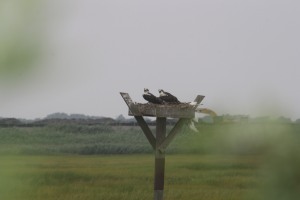
Weather can affect migration and when Coley 2 left New York on September 2, 2013, he was headed into some pretty serious thunderstorms. He only traveled 44 miles and settled in Trenton, New Jersey for the first night of his trip. Coley 2 continued onward and made remarkable time considering his damp start. He arrived at his winter home, Lake Valencia in Venezuela, South America on September 17, 2013.
While at Lake Valencia, Coley 2 will spend his time fishing, eating, and resting until his internal signal tells him it is time to return to the nesting area.
What inspires birds to migrate north or south and how do they find their way? There are only scientific speculations but some say it is hormonal changes and/or the changes in the length of day/night hours that motivate migration. Navigation is a bit trickier to understand but some say birds rely on the position of the sun, those that travel at night rely on the North Star, and some scientists say that birds use landmarks to help them find their way just as humans do. That doesn’t explain a bird’s first migration. How would they know the landmarks if they never traveled before?
Scientists had been monitoring Coley 2 at Lake Valencia and were happy to note that he must know the weather is bad in the northeastern US and stayed a little longer at his warm winter home but on Sunday, March 16, 2014, just a few days ago, Coley 2 left and was traveling at a remarkable 250 miles per day. 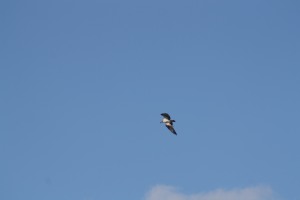
Scientists are not monitoring Coley 1, but he and his female partner were spotted on their platform nest in Jamaica Bay on March 23, 2014. Will Coley 2 be far behind? Will his female partner arrive before he does? Follow Coley 2 on his magnificent journey and you can even predict when he might arrive at his summer home: http://www.jamaicabayosprey.org.
For more details about the National Parks of New York Harbor Conservancy osprey project and to predict when Coley 2 will arrive go to: http://www.jamaicabayosprey.com http://www.nyharborparks.org
Footnotes: Another fabulous place to visit is the Cape May Bird Observatory. Their website for information is: http://www.njaudobon.org


By: darlenebeckjacobson,
on 3/23/2014
Blog:
Darlene Beck-Jacobson
(
Login to Add to MyJacketFlap)
JacketFlap tags:
Nature,
Activities,
Outdoor activities,
cooking with kids,
spring activities,
gardening with children,
good health habits,
Home Schooling Ideas,
Children,
Add a tag
I don’t know about you, but after this long and tenacious winter, I look forward to getting outdoors as soon as the weather is warmer. Most kids love the natural world and what better way to introduce them to the wonders of nature than with a garden. Planting and watching things grow is rewarding, satisfying and good exercise. Don’t know where to begin? There are many wonderful resources and websites with specific tips and ideas for gardening with children. Before I list some of these sites, here are a few things to keep in mind:
1. Keep things simple. You don’t have to dig up your entire yard to reap the benefits of gardening. Start with a small raised bed or a large container or two.
2. Try fast growing crops such as lettuces, chives, radishes, spinach, herbs and the like.
3. Let your kids have a say in what they grow. If you’re trying to encourage them to eat more veggies, let them pick the ones they would like to try. I’ll bet they get excited about tasting them once they see them pop up in the garden.
4. Make weeding and watering part of the daily routine. That way you will keep the unwanted weeds under control and ensure that the seeds get a fair chance at sprouting. Always weed when soil is moist to avoid damaging roots of tender plants.
5. Check out the library for gardening books for beginners and children. 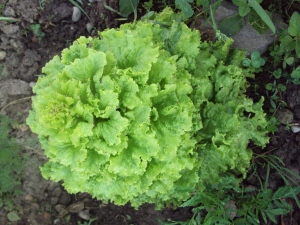
Make it fun! See whose seeds sprout first, whose veggies grow fastest, are tallest, etc. When it comes time to harvest, let the kids plan a meal using the fruits – and veggies – they grew.
Here are some great gardening sites to get you started:
Gardening with Children from Earth Easy
Ten Tips on Gardening with Kids from the American Community Gardening Association
Gardening with Children from the BBC This site tells you how to compost, cultivate earth worms, use beneficial insects for pollination and has many child-friendly activities related to gardening and the outdoors.
Stimulating Imagination in the Garden from Kids Gardening
My First Garden from the University of Illinois
Happy Growing – and eating! 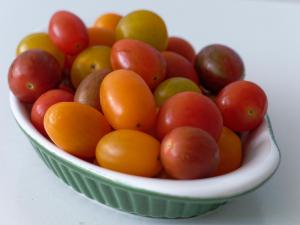


By: darlenebeckjacobson,
on 8/23/2013
Blog:
Darlene Beck-Jacobson
(
Login to Add to MyJacketFlap)
JacketFlap tags:
Uncategorized,
Nature,
Activities,
Outdoor activities,
summer fun,
good health habits,
hiking/biking trails,
Rails to Trails Conservancy,
www.traillink.com,
Add a tag
If you’re looking for some new trails or pathways to hike and bike what’s left of summer and into fall, check out http://www.traillink.com
This site is hosted by the Rails-to-Trails Conservancy, a non-profit agency that has helped convert more than 21,000 miles of old railroad beds into trails across the U.S.


There are many wonderful ways to enjoy physical activity. As we wind down the days of summer, let the kids – and adults – in the neighborhood have a BACKYARD OLYMPICS.
You can set up an area with an obstacle course and see who can complete it. Crawling through a “tunnel”, jumping over ropes of various heights, rolling, running, and crab walking are all fun ways to compete in events. Walking like various animals is also fun (especially if accompanied by animal sounds). Endurance activities might include who can jump rope or keep a hula hoop going the longest. A fun spin on ball games might be a water balloon toss, or raw egg toss.
Finish up the day’s fun with Popsicle eating or watermelon seed spitting contests. Give all children a chance to feel special. You can award ribbons for the Best Sport, Purplest Tongue, Coolest Crab Walker, Awesome Hula Hooper, etc. You can even name your team and paint T-shirts for the big day.
It’s even more fun if adults “act like kids” by: wearing a swimsuit all day, being barefoot all day, digging in the dirt, eating a Popsicle for breakfast, running under a sprinkler.
Enjoy these last few weeks of summer and get physical!


By: darlenebeckjacobson,
on 7/8/2013
Blog:
Darlene Beck-Jacobson
(
Login to Add to MyJacketFlap)
JacketFlap tags:
Recipes,
Activities,
web sites,
Outdoor activities,
cooking with kids,
summer fun,
Home Schooling Ideas,
Free summer fun for kids,
Children,
Add a tag
There are some great websites with all kinds of activities for children of all ages. Here are three that have a wealth of outdoor games, activities and recipes for fun all summer long.
1. spoonful.com: Water games, scavenger hunt, Tacos and Bridges (check it out!) and lots more .
2. Parenting.com: Eleven water games and other activities for kids. We all knew water was fun. These activities will keep the kids cool on a hot day.
3. Alphamom.com has games such as driveway baseball, elbow tag, musical sprinklers and more. These games are great for parties and get-togethers.
Kind of makes me wish I was a kid again. It’s a great excuse to put on a swimsuit and join the fun!


By: darlenebeckjacobson,
on 7/1/2013
Blog:
Darlene Beck-Jacobson
(
Login to Add to MyJacketFlap)
JacketFlap tags:
Home Schooling Ideas,
July 4th fun for kids,
make your own ice cream,
Children,
Recipes,
Activities,
web sites,
Outdoor activities,
cooking with kids,
summer fun,
Add a tag
Across the country families and communities will be celebrating our nation’s 237th birthday with parades, picnics and fireworks. If you’d like to get in on some local fun, check out these sites. Each has information about what’s happening in your area of the country.
1. www.Zvents.com 2. http://www.eventbrite.com 3. http://www.99events.com
You can also GRILL FOR A CAUSE this summer by hosting a barbecue to raise money for the USO. When you register your event at: http://www.bbqforthetroops.org you create a webpage where your guests can donate to support men and women in the armed forces.
July is NATIONAL ICE CREAM MONTH. You can celebrate with your favorite treat and even try making your own. For directions on how to make ICE CREAM IN A PLASTIC BAG go to: eHow:How to Make Ice Cream in a Bag
You can also try: http://www.pbskids.org Homemade Ice Cream
HAPPY INDEPENDENCE DAY!


By: darlenebeckjacobson,
on 6/24/2013
Blog:
Darlene Beck-Jacobson
(
Login to Add to MyJacketFlap)
JacketFlap tags:
Inspiration,
Nature,
Activities,
Outdoor activities,
summer fun,
Science activity,
gardening with children,
Home Schooling Ideas,
attracting butterflies to the garden,
monarchwatch.org,
Children,
Add a tag
Tis the season for that beautiful insect that even bug hating people can’t resist…butterflies. If you want to lure these colorful creatures to your backyard, try planting MILKWEED. (see photo) Go to: http://www.monarchwatch.org to find out which varieties of milkweed will thrive in your area. The plants are easy to grow and come back year after year. You can also mix them in with your other flowers. 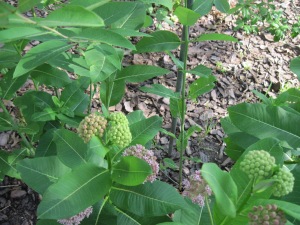 Your garden should be aflutter in no time.
Your garden should be aflutter in no time.
If you’d like to watch the MIGRATION of the Monarch butterfly, catch the IMAX film FLIGHT OF THE BUTTERFLIES IN 3D at a museum near you.


By: darlenebeckjacobson,
on 6/17/2013
Blog:
Darlene Beck-Jacobson
(
Login to Add to MyJacketFlap)
JacketFlap tags:
Children,
Inspiration,
Activities,
Crafts,
web sites,
Outdoor activities,
cooking with kids,
summer fun,
Home Schooling Ideas,
Free summer fun for kids,
Add a tag
Now that school is out for the summer, you may be wondering how to keep your children entertained without spending tons of money. If finances are tight, don’t despair. There are plenty of fun filled activities you can do with kids to make the summer a memorable one.
1. Pitch a tent for the GREAT AMERICAN BACKYARD CAMPOUT. You can sleep under the stars in your own backyard. Identify constellations, make s’mores (check out my recipe under the recipe section of this blog). Tell stories, sing songs, eat hotdogs, and do everything you’d do at a camp far away. Visit: http://www.nwf.org/great-american-backyard-campout.aspx
2.Check out: http://www.parade.com/summerschool for 14 days of how-to steps and expert tips on everything from building a sand castle, to how to skip stones. You can also learn things like HOW TO HOST A BACKYARD MOVIE NIGHT, SPOT CONSTELLATIONS, TEACH KIDS TO FISH, and even HOW TO MAKE YOUR OWN ICE CREAM.
3. Put on a Show. A Puppet Show that is. There are tons of videos and sites on how to make your own puppets and puppet theatres. To get you started, enter: Making puppets in your search engine and a load of sites will appear. Here’s a good one:
http://www.about.com/od/puppets 
You can also use stuffed toys, pencils with funny tops, or socks with painted faces. Or even cookies! (see photos) Let your imagination run wild.
To make it a real event, sell popcorn and lemonade.
 4.And…you can’t go wrong with water. If you don’t have a pool, a sprinkler on a hose works great. Squirt guns and water balloon fights are sure cures for boredom and cool everyone off on a hot day. For little ones, fill up a bucket with water and let them “paint” the sidewalk to their hearts content. Add a few cups for pouring and you’ll keep them entertained for a long time.
4.And…you can’t go wrong with water. If you don’t have a pool, a sprinkler on a hose works great. Squirt guns and water balloon fights are sure cures for boredom and cool everyone off on a hot day. For little ones, fill up a bucket with water and let them “paint” the sidewalk to their hearts content. Add a few cups for pouring and you’ll keep them entertained for a long time.


By: darlenebeckjacobson,
on 5/31/2013
Blog:
Darlene Beck-Jacobson
(
Login to Add to MyJacketFlap)
JacketFlap tags:
www.gailterp.com,
Home Schooling Ideas,
gardening for chilldren,
Children,
Children's Books,
Books,
Nature,
Activities,
stories for children,
web sites,
Outdoor activities,
Add a tag
|
GAILTERP.COM published this wonderful post about gardening for children. She has some great books and websites that will help you and your child get started on gardening.
Grow Garden Grow! Gardening Books for Kids
Here in the northeast, gardens are being planned and have been planted. Gardening is a GREAT family activity. There’s research, engaging plans, the great outdoors, and all the lovely tending and harvesting. Here are some books to get you psyched!
First Peas to the Table by Susan Grigsby, illustrated by Nicole Tadgell
Maya’s teacher announces that the class will have a gardening contest just like Thomas Jefferson – and the first student to grow enough peas to fill a bowl wins. Maya really wants to win and works hard to help her pea plants grow. This book has gardening, history and friendship.
It’s Our Garden: From Seeds to Harvest in a School Gardenby George Ancona
This book carefully documents one school’s garden project. It covers the planning, planting, observing, harvesting and celebrating. There is a good balance between clear text and lots of photographs. Inspiring!
The Curious Garden by Peter Brown
This is a wonderful book! Liam finds a scraggly garden growing on some unused train tracks. He isn’t much of a gardener but he learns over time. When the garden grows curious, it spreads to other areas, wherever it feels like. There is real magic in this book.
Grow Your Own Monsters by Nicola Davies and Simon Hickmott, illustrated by Scoular Anderson
So what kind of monster plants are they talking about? How about Venus Fly Trap (eats flies), Voodoo Lily (looks like a snake and smells like a corpse), Giant Echium (20 feet tall) and others. Careful directions are given.
The Garden Project by Margaret McNamara, illustrated by Mike Gordon
A first grade class at Robin Hill School converts their sandbox into a garden. They plant, water, weed, harvest and eat the plants in their garden. This is a Ready-to-Read Level 1 reader.
Gardening Projects for Kids by Jenny Hendy
This book has lots of information that’s clearly written and colorfully illustrated. It explains how to start your garden and gives projects for growing flowers, fruits, vegetables, plus other garden-related projects. It’s written for parents but kids could find lots to interest them.
Max’s Magic Seeds by Géraldine Elschner, illustrated by Jean-Pierre Corderoch
Max’s Uncle Bill gives him a sack of seeds, telling him to secretly drop them all over town. When the flowers start to bloom, everyone is delighted. Will they figure out who has been planting the seeds? This is a fun story with magical pictures.
A Fruit is a Suitcase for Seeds by Jean Richards, illustrated by Anca Hariton
I’d never thought of this before but the title makes sense – a fruit is a suitcase for seeds! And the suitcases are so different – in size, shape, color and how they transport their seeds around.
Secrets of the Garden: Food Chains and the Food Web in Our Backyard by Kathleen Weidner Zoehfeld, illustrated by Priscilla Lamont
This book does an amazing job of showing lots of different food chains in clear and entertaining ways. It uses colorful illustrations, clear text, and speech bubbles to create an interesting and informative book.
The Sunflower House by Eve Bunting, illustrated by Kathryn Hewitt
A boy plants sunflower seeds in a wide circle. When they grow, they create a perfect house for him and his friends. I want to try this!
Talia and the Rude Vegetables by Linda Elovitz Marshall, illustrated by Francesca Assirelli
Talia’s grandmother sends her to the garden to pick root vegetables for a Rosh Hashanah stew. But Talia thinks she said “rude” vegetables. It’s funny how she decides which vegetables are rude. The recipe is included on the last page – looks good!
The Goodbye Cancer Garden by Janna Mattkies, illustrated by Kristi Valiant
When Janie and Jeffrey learn their mother has cancer, Janie suggests they plant a Goodbye Cancer Garden. The kids and their parents each choose 2 vegetables to plant and spend a long spring and summer tending the garden. This is a colorful and hopeful book about family and recovery.
A Seed is Sleepy by Dianna Hutts Ashton, illustrated by Sylvia Long
I am a big fan of this series (An Egg is Quiet, A Rock is Lively…). This book shows many kinds of seeds, how they grow, and how they get around. The information is clearly presented and the illustrations dance.
MORE WEBSITES
Gardening with Children from Earth Easy
Garden Mosaics from the American Community Gardening Association
Rebel Tomato from the American Community Gardening Association
Ten Tips on Gardening with Kids from the American Community Gardening Association
Gardening with Kids from Gardening with Kids
Gardening with Children from the BBC
Stimulating Imagination in the Garden from Kids Gardening
My First Garden from the University of Illinois
School Garden Weekly: Instructional Activities for School Gardens
|
|
Please visit Gail’s site for more posts about gardening as well as other great books and activities for children of all ages. http://www.gailterp.com



Find more of this week's Wordless Wednesday (or Wordful) posts at 5 Minutes for Mom.


Carrots and searching for potatoes.
Find more of this week's Wordless Wednesday (or Wordful) posts at 5 Minutes for Mom.

The area fire departments competed in a water fight competition. A damp mist fell on us as we observed the teams work together to spray the barrel across the line with the water stream. My daughter kept a close watch for rainbows.
Find more of this week's Wordless Wednesday (or Wordful) posts at 5 Minutes for Mom.
View Next 20 Posts
 When solid, peel back the carton and slice the cake into ONE INCH THICK pieces that you can insert into your suet feeder or hang from a wire basket.
When solid, peel back the carton and slice the cake into ONE INCH THICK pieces that you can insert into your suet feeder or hang from a wire basket.














































Feeding winter birds is really a rewarding winter activity…